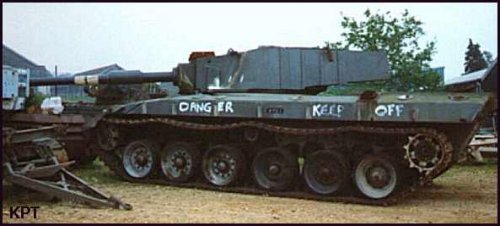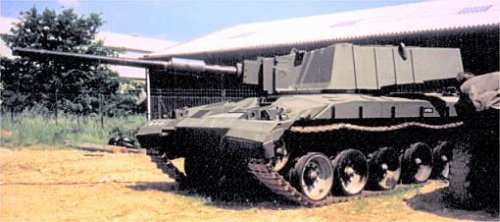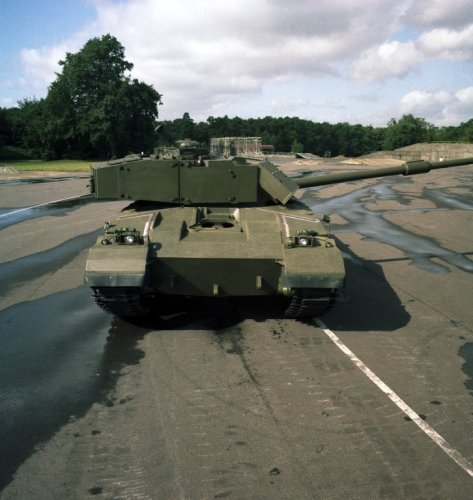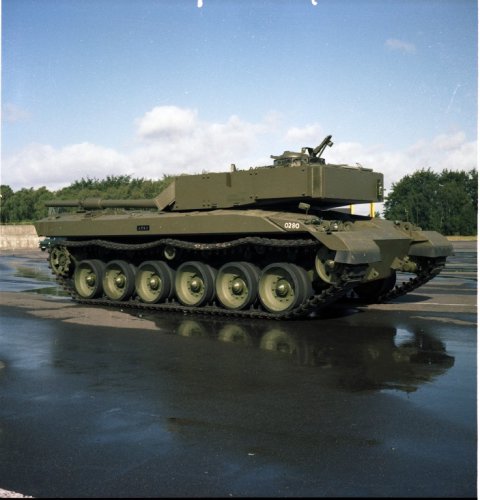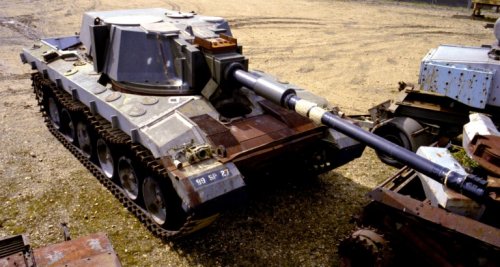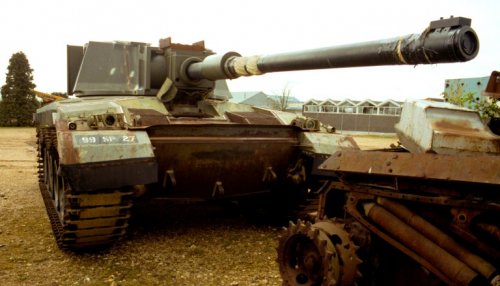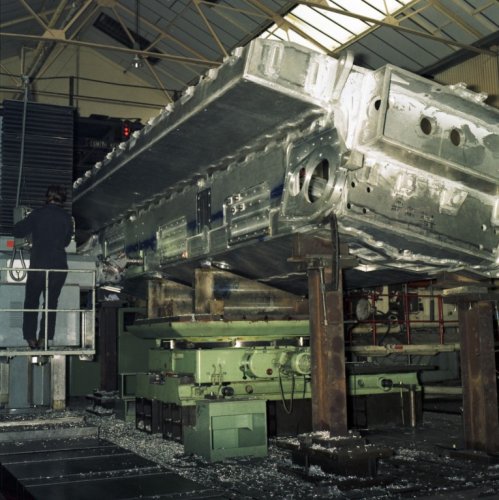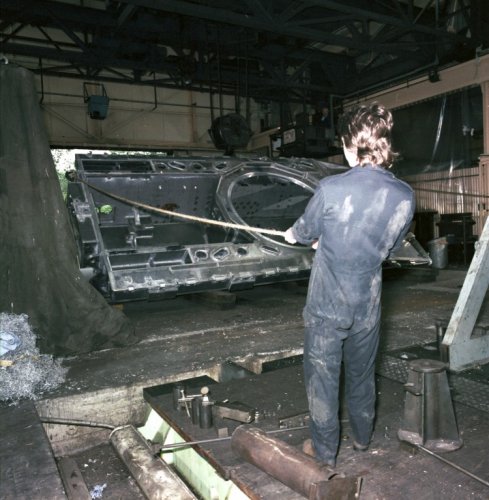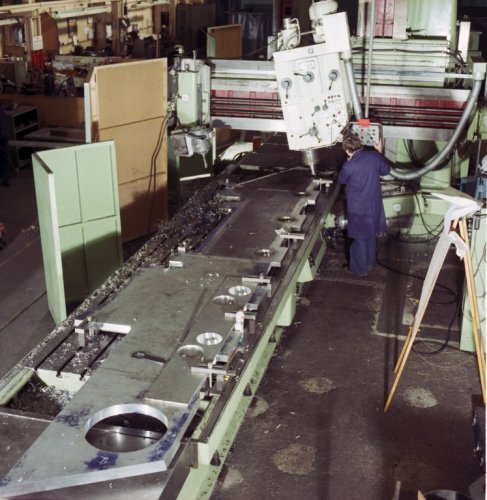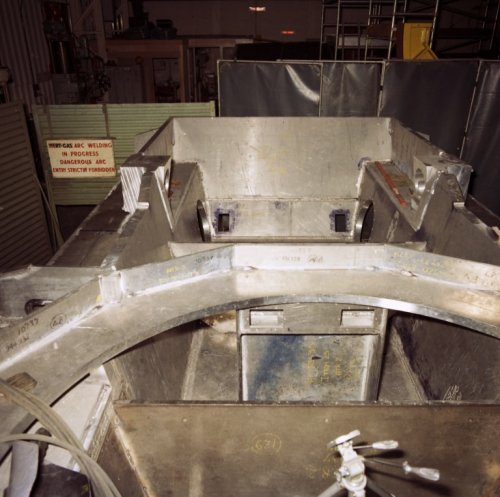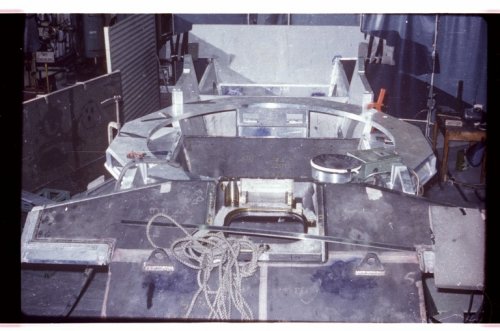You are using an out of date browser. It may not display this or other websites correctly.
You should upgrade or use an alternative browser.
You should upgrade or use an alternative browser.
MBT-80 British German
- Thread starter JAZZ
- Start date
JAZZ,
Surprising very little information is available. Actually the project you are looking for is the Anglo-German Future MBT. The picture you have attached is the FV-4601 or MBT-80 (replacement for the Cheiftain Tank) which is the follow up after the failure of the Anglo German Future MBT. Some information is available at http://www.geocities.com/Pentagon/Quarters/7413/fv4601_mbt80.html
Surprising very little information is available. Actually the project you are looking for is the Anglo-German Future MBT. The picture you have attached is the FV-4601 or MBT-80 (replacement for the Cheiftain Tank) which is the follow up after the failure of the Anglo German Future MBT. Some information is available at http://www.geocities.com/Pentagon/Quarters/7413/fv4601_mbt80.html
Kugelblitz
ACCESS: Restricted
- Joined
- 25 May 2008
- Messages
- 41
- Reaction score
- 21
By the looks of it, it doesn't have its Chobham armour fitted.
One of the strange features of the MBT80 I have read is that the gun was to be offset in the turret. But I would have thought that that would have caused problems for the training gear.
One of the strange features of the MBT80 I have read is that the gun was to be offset in the turret. But I would have thought that that would have caused problems for the training gear.
Wonder if the Tank Museum at Bovington has any information, of course given the UK Official Secrets Act which has a span of 50 years, we shall find out more in another 22 years or so, along with the constituents of Chobham armour.
- Joined
- 2 January 2006
- Messages
- 659
- Reaction score
- 284
In the JagdChieftan thread there is a link to a webshots site on the reserve collection hall at Bovington which appears to include this prototype as well as some others such as the British S-Tank style demonstrator.
G
G
Stuart Galbraith
ACCESS: Restricted
- Joined
- 22 July 2008
- Messages
- 1
- Reaction score
- 0
Ive been looking into the history of the development of Challenger1, and it seems fairly clear to me that MBT80 and the Anglo German Tank Project are 2 different things. AGTP seems largely based around fixed fighting compartment machines, or fairly similar to the Swedish S tank. The British army evaluated them for a while to see if it would adequately fulfill their needs in West Germany. Needless to say it didnt.
The Germans had a similar concept which I think was based on Leopard1 hulls, and at least one (I think several) had 2 twin gun 120mm smoothbore guns. I think the concept was to find a way round the problem of the distance you needed to slew a gun onto target, though I admit my understanding of this is shaky. The British version was based around Chieftain components fitted to a purpose built chassis, again with a fixed fighting compartment, but it was envisaged, with only one gun.
This fell through for a number of reasons. I dont think West Germany or Britain had their heart in a joint programme anyway (Germany it will be remembered got its fingers burnt with MBT70), and Britain evaluated the fixed gun tank in a survey of various replacements for Chieftain. If I recall correctly it scored even less than an upgraded Chieftain in the evaluation (which Im assuming was Shir1/Khalid).
Britain went to MBT80 when it was clear that AGTP wouldnt amount to anything. I would have to check the dates, but if memory is right, this would be about 1976-77. We played with the concept for a few years, evaluating engine concepts and building the 2 test rigs you see here. But they never actually built a prototype, and it was clear rather than getting something for 1980, it would be more like 1990. By 1980 I think the MOD were seriously looking for alternatives, and by 1981 the decision had been made to use a machine based upon the development work for Shir2. Which of course became challenger 1.
MBT80 was due to be fitted with a hunter killer sight, similar to Challenger2, and for various reasons ive a suspicion the turret is related to that fitted to Vickers Mk7 and that of Challenger2. But it would be tough to prove it. No the MBT80 doesnt have chobham fitted, and quite likely it never did.
If there is a link between MBT80 and 'JagdChieftain', it would be the use of aluminium components in the hull. I gather it was quite extensive in both of these, and the reason for Jagdchieftain surviving at all was due to them wanting to test corrosion of aluminium hulled vehicles. I gather there was some ghastly steel-aluminium sandwhich contruction invovled in the MBT80 which was prone to cracking.
Hope this helps. There are some far better informed people than myself who discussed this on tanknet.
http://63.99.108.76/forums/index.php?showtopic=24864&hl=jagdchieftain
The Germans had a similar concept which I think was based on Leopard1 hulls, and at least one (I think several) had 2 twin gun 120mm smoothbore guns. I think the concept was to find a way round the problem of the distance you needed to slew a gun onto target, though I admit my understanding of this is shaky. The British version was based around Chieftain components fitted to a purpose built chassis, again with a fixed fighting compartment, but it was envisaged, with only one gun.
This fell through for a number of reasons. I dont think West Germany or Britain had their heart in a joint programme anyway (Germany it will be remembered got its fingers burnt with MBT70), and Britain evaluated the fixed gun tank in a survey of various replacements for Chieftain. If I recall correctly it scored even less than an upgraded Chieftain in the evaluation (which Im assuming was Shir1/Khalid).
Britain went to MBT80 when it was clear that AGTP wouldnt amount to anything. I would have to check the dates, but if memory is right, this would be about 1976-77. We played with the concept for a few years, evaluating engine concepts and building the 2 test rigs you see here. But they never actually built a prototype, and it was clear rather than getting something for 1980, it would be more like 1990. By 1980 I think the MOD were seriously looking for alternatives, and by 1981 the decision had been made to use a machine based upon the development work for Shir2. Which of course became challenger 1.
MBT80 was due to be fitted with a hunter killer sight, similar to Challenger2, and for various reasons ive a suspicion the turret is related to that fitted to Vickers Mk7 and that of Challenger2. But it would be tough to prove it. No the MBT80 doesnt have chobham fitted, and quite likely it never did.
If there is a link between MBT80 and 'JagdChieftain', it would be the use of aluminium components in the hull. I gather it was quite extensive in both of these, and the reason for Jagdchieftain surviving at all was due to them wanting to test corrosion of aluminium hulled vehicles. I gather there was some ghastly steel-aluminium sandwhich contruction invovled in the MBT80 which was prone to cracking.
Hope this helps. There are some far better informed people than myself who discussed this on tanknet.
http://63.99.108.76/forums/index.php?showtopic=24864&hl=jagdchieftain
- Joined
- 26 January 2011
- Messages
- 2,226
- Reaction score
- 645
amsci99 said:Wonder if the Tank Museum at Bovington has any information, of course given the UK Official Secrets Act which has a span of 50 years, we shall find out more in another 22 years or so, along with the constituents of Chobham armour.
The Official Secrets Act has no such span. There is however, separate security regulations which allows the government to classify information under certain time spans before their release for publication, usually 10, 20, 30 or 50 years.
rickshaw said:The Official Secrets Act has no such span. There is however, separate security regulations which allows the government to classify information under certain time spans before their release for publication, usually 10, 20, 30 or 50 years.
rickshaw,
I stand corrected and thank you for pointing out the error.
- Joined
- 27 December 2005
- Messages
- 17,752
- Reaction score
- 26,458
Indeed, and declassification isn't automatic, if the information is deemed still sensitive it can be retained indefinitely.
- Joined
- 27 December 2005
- Messages
- 17,752
- Reaction score
- 26,458
Anyone near Kew in London might want to look at the National Archives. Here's a few files that might be interesting. You can use your digital camera to copy records without charge.
DEFE 48/1076 Cost effectiveness of Chieftain, Challenger and MBT 80 (Main Battle Tank 80)
DEFE 24/1369 Chieftain tank replacement (Main Battle Tank - MBT 80)
DEFE 70/143 Future Main Battle Tank (MBT 80): armament; Trilateral assessment
DEFE 70/207 Replacement of Chieftain Tank (Future Main Battle Tank - MBT 80): policy
DEFE 70/208 Replacement of Chieftain Tank (Future Main Battle Tank - MBT 80): policy
WO 194/1967 A development cost plan for a Main Battle Tank: Project - MBT 80
WO 194/1973 Main Battle Tank (MBT) 80 mobility study with various engines
WO 194/2001 The electrical system and electronic equipment for Main Battle Tank (MBT) 80
DEFE 15/2210 A joint UK / FRG study prepared by RARDE Fort Halstead and IABG Ottobrunn of a new German concept for a future Main Battle Tank
DEFE 48/240 Study of future main battle tank options to replace CHIEFTAIN
DEFE 48/161 Future main battle tank trial evaluation
DEFE 48/280 Future main battle tank parametric studies
DEFE 48/544 Future main battle tank parametric study: value of increased mobility
DEFE 48/545 Future main battle tank trial evaluation, part one: Federal Republic of Germany scenario with and without guided weapons
DEFE 48/546 Future main battle tank trial evaluation, part two: UK scenarios 1 and 3
DEFE 48/547 Future main battle tank trial evaluation, part three: UK scenario 4, the night battle
DEFE 48/548 Investigation of differences between Defence Operational Analysis Establishment and IABG results in the future main battle tank M48 trial guns
DEFE 13/1368 Main Battle Tank: Anglo-German collaboration 1969 Jan 01 - 1970 Dec 31
DEFE 13/1369 Chieftain tanks: engine problems and improvements; main battle tank armour development (Burlington) proposed collaboration with Germany
DEFE 48/1076 Cost effectiveness of Chieftain, Challenger and MBT 80 (Main Battle Tank 80)
DEFE 24/1369 Chieftain tank replacement (Main Battle Tank - MBT 80)
DEFE 70/143 Future Main Battle Tank (MBT 80): armament; Trilateral assessment
DEFE 70/207 Replacement of Chieftain Tank (Future Main Battle Tank - MBT 80): policy
DEFE 70/208 Replacement of Chieftain Tank (Future Main Battle Tank - MBT 80): policy
WO 194/1967 A development cost plan for a Main Battle Tank: Project - MBT 80
WO 194/1973 Main Battle Tank (MBT) 80 mobility study with various engines
WO 194/2001 The electrical system and electronic equipment for Main Battle Tank (MBT) 80
DEFE 15/2210 A joint UK / FRG study prepared by RARDE Fort Halstead and IABG Ottobrunn of a new German concept for a future Main Battle Tank
DEFE 48/240 Study of future main battle tank options to replace CHIEFTAIN
DEFE 48/161 Future main battle tank trial evaluation
DEFE 48/280 Future main battle tank parametric studies
DEFE 48/544 Future main battle tank parametric study: value of increased mobility
DEFE 48/545 Future main battle tank trial evaluation, part one: Federal Republic of Germany scenario with and without guided weapons
DEFE 48/546 Future main battle tank trial evaluation, part two: UK scenarios 1 and 3
DEFE 48/547 Future main battle tank trial evaluation, part three: UK scenario 4, the night battle
DEFE 48/548 Investigation of differences between Defence Operational Analysis Establishment and IABG results in the future main battle tank M48 trial guns
DEFE 13/1368 Main Battle Tank: Anglo-German collaboration 1969 Jan 01 - 1970 Dec 31
DEFE 13/1369 Chieftain tanks: engine problems and improvements; main battle tank armour development (Burlington) proposed collaboration with Germany
Found this on Arcane Fighting Vehicles by Graham Matthews
"MBT-80 was Britain's unilateral programme to produce a Chieftain replacement following the termination of the Anglo-German FMBT project.
99SP27 is currently (2002) at Bovington.
The hull, identified as ATR 2, was an automotive test rig of which it has been said "could only have come out of Chertsey" (FVRDE/MVEE). It is constructed of steel and aluminium in an effort to save weight: steel at the front, aluminium at the rear with a sandwich layer of stainless steel between the two to overcome the impossibility of welding steel and aluminium together. Cracks are apparent at the rear of the vehicle where side and rear plates meet.
Unfortunately the turret and hull of 99SP27 do not belong together.
The turret was part of a research programme to study offset mounts. If successful it may have found its way into MBT-80.
The turret that is closely related to what would have been inside MBT-80 is the Weapon System Demonstrator (WSD), formerly the Fire Control Rig (FCR),which is also at the Tank Museum. This is mounted on a FV4030 hull.
When MBT-80 was cancelled the FCR turret continued on as a Research Programme at MVEE Chertsey (1984-RARDE Chertsey) where, amongst other things, various gunner's two axis stabilised sights from UK manufacturers were trialled. These sights were with the rig when the MBT-80 project stopped, so in all probability the winning design would have found its way onto MBT-80. The commander's cupola was stabilised in traverse and the sight mirror stabilised in elevation. As part of the programme the commander also received a Panoramic, Thermal Imager, Laser Integrated (PANTILI) Sight. As the title suggests this was a 360 degree rotating thermal imager fitted with a CO2 (Carbon Dioxide) laser. This was fitted on the loaders side of the roof, but the images were available to both the commander and gunner in much the same way as M1A2 now has CITV. Pantili now resides at the Aldershot Military Museum and WSD has a wooden mockup fitted. Internally the FCR had a digital databus linking the main sub systems. The Fire Control Computer processing was fully digital and by the mid-80's the Gun Control Equipment processing was all digital too. For field trials the turret was originally fitted to a Chieftain hull, but as the programme progressed it later transferred to the hull it is now on at Bovington. The turret is actually a FV4211 turret, presumably because the interior would have been similar to MBT-80 (if one was ever to be built). Should you see the WSD at Bovington you will notice thick vertical plates mounted on the turret front either side of the gun, these are simply ballast weights to raise the inertia of the turret to represent that of an armoured turret. "
http://arcaneafvs.com/fv4601_mbt80.html
"MBT-80 was Britain's unilateral programme to produce a Chieftain replacement following the termination of the Anglo-German FMBT project.
99SP27 is currently (2002) at Bovington.
The hull, identified as ATR 2, was an automotive test rig of which it has been said "could only have come out of Chertsey" (FVRDE/MVEE). It is constructed of steel and aluminium in an effort to save weight: steel at the front, aluminium at the rear with a sandwich layer of stainless steel between the two to overcome the impossibility of welding steel and aluminium together. Cracks are apparent at the rear of the vehicle where side and rear plates meet.
Unfortunately the turret and hull of 99SP27 do not belong together.
The turret was part of a research programme to study offset mounts. If successful it may have found its way into MBT-80.
The turret that is closely related to what would have been inside MBT-80 is the Weapon System Demonstrator (WSD), formerly the Fire Control Rig (FCR),which is also at the Tank Museum. This is mounted on a FV4030 hull.
When MBT-80 was cancelled the FCR turret continued on as a Research Programme at MVEE Chertsey (1984-RARDE Chertsey) where, amongst other things, various gunner's two axis stabilised sights from UK manufacturers were trialled. These sights were with the rig when the MBT-80 project stopped, so in all probability the winning design would have found its way onto MBT-80. The commander's cupola was stabilised in traverse and the sight mirror stabilised in elevation. As part of the programme the commander also received a Panoramic, Thermal Imager, Laser Integrated (PANTILI) Sight. As the title suggests this was a 360 degree rotating thermal imager fitted with a CO2 (Carbon Dioxide) laser. This was fitted on the loaders side of the roof, but the images were available to both the commander and gunner in much the same way as M1A2 now has CITV. Pantili now resides at the Aldershot Military Museum and WSD has a wooden mockup fitted. Internally the FCR had a digital databus linking the main sub systems. The Fire Control Computer processing was fully digital and by the mid-80's the Gun Control Equipment processing was all digital too. For field trials the turret was originally fitted to a Chieftain hull, but as the programme progressed it later transferred to the hull it is now on at Bovington. The turret is actually a FV4211 turret, presumably because the interior would have been similar to MBT-80 (if one was ever to be built). Should you see the WSD at Bovington you will notice thick vertical plates mounted on the turret front either side of the gun, these are simply ballast weights to raise the inertia of the turret to represent that of an armoured turret. "
http://arcaneafvs.com/fv4601_mbt80.html
- Joined
- 27 September 2006
- Messages
- 6,417
- Reaction score
- 6,823
It would be interesting to learn more about the German part of the collaboration effort.
Given that Leopard 2 remains in service in its latest versions the UK German tank was
presumably intended to replace the Leopard 1s and M48s that remained in Bundesheer
service after the Leopard 2 entered service. Apart from the Chobham armour and cost sharing
what were the Germans looking for in a partnership with the Brits?
For some reason the coverage in German books on the Leopard family is extensive on the MBT 70
and even the casemate gun Leopard prototypes but very silent on the Anglo-German stuff.
The documents at Kew might help produce another book from someone. Sadly I lack the technical
expertise to make much use of them. It would be interesting to know if any sketches or drawings
are contained therein.
UK 75
Given that Leopard 2 remains in service in its latest versions the UK German tank was
presumably intended to replace the Leopard 1s and M48s that remained in Bundesheer
service after the Leopard 2 entered service. Apart from the Chobham armour and cost sharing
what were the Germans looking for in a partnership with the Brits?
For some reason the coverage in German books on the Leopard family is extensive on the MBT 70
and even the casemate gun Leopard prototypes but very silent on the Anglo-German stuff.
The documents at Kew might help produce another book from someone. Sadly I lack the technical
expertise to make much use of them. It would be interesting to know if any sketches or drawings
are contained therein.
UK 75
- Joined
- 22 April 2012
- Messages
- 2,258
- Reaction score
- 2,315
There is a very brief mention in 'Cold War: Hot Science' where it references the FV4211 as being part of the conceptual lineage. The reasons for cancellation appear to be a combination of programme delays and the Iranian cancellation of the Shir-2 programme which meant that Vickers was going to be left without tank work for several years. So MBT-80 was cancelled and the Shir-2 was reworked as the Challenger 1 to keep Vickers going.
The German part of MBT-80 appears to be nil, MBT-80 was a unilateral project that came about after the failure of the collaborative effort. MBT-80 would have had Chobham and perhaps a 1,500hp diesel with aluminium contruction possibly similar to the XM-1 and a true hunter-killer capability similar to the Challenger 2.
The German part of MBT-80 appears to be nil, MBT-80 was a unilateral project that came about after the failure of the collaborative effort. MBT-80 would have had Chobham and perhaps a 1,500hp diesel with aluminium contruction possibly similar to the XM-1 and a true hunter-killer capability similar to the Challenger 2.
Last edited:
- Joined
- 27 September 2006
- Messages
- 6,417
- Reaction score
- 6,823
The thread and nao refs cover the story of anglo german tank development before mbt 80 as well. If mbt 80 owes nothing to this effort, all the more interesting to hear what they got out of it.
- Joined
- 26 May 2011
- Messages
- 2,319
- Reaction score
- 3,472
While rummaging at Kew I turned up a file from the Operational Requirements Commitee in late 1972 that mentions "MBT-85 - Future Main Battle Tank". Above the line containing "MBT-85" is "FV4211" and in the line below is "MICV".
I'm familiar with MBT-70, MBT-80 and FV.4211. MICV ended up as Warrior. So what was MBT-85?
Chris
I'm familiar with MBT-70, MBT-80 and FV.4211. MICV ended up as Warrior. So what was MBT-85?
Chris
Przezdzieblo
ACCESS: Restricted
- Joined
- 4 July 2007
- Messages
- 29
- Reaction score
- 10
MBT-85 designation might be connected to more than one project. If remember correctly, this designation appear around 1969/70, when the plan was to go with uparmoured Chieftain (mk 5/2 aka FV 4211, project "Almagest") and to collect experience that would be base of the new MBT, which could go to service in circa 1985. After the British started cooperation with German on so called FMBT (it is also a popular acronym, not only British), in some documents this vehicle was mentioned as MBT-80 or MBT-85 (depends how optimistic were those guys about date of introduction). The former designation was later used in unilateral British tank programme, which was cancelled in late 1970s.
Oh, there was also MBT-79 designation somewhere. I cannot remember now the timescale for that. But for sure it was the alternate designation of one of mentioned above projects.
Oh, there was also MBT-79 designation somewhere. I cannot remember now the timescale for that. But for sure it was the alternate designation of one of mentioned above projects.
- Joined
- 16 December 2010
- Messages
- 3,820
- Reaction score
- 4,233
Sorry to go off topic a bit, but I was reading the thread and it triggered a memory of a novel I'd read some years ago.
The plot-line was that Vickers had designed a new tank 'on spec' and having failed to interest the British Army in it was showing it around the Middle East to interested parties.
One of these was Jordan (The novel may have been inspired by the Shir1/Khalid story). The Jordanians gave it to one of their tank brigades to test, unfortunately the brigade was the one the Jordanian govt had shoved all the 'reliable' Palestinians into after Black September and they decided to sell it to the Russians or some such.
The one feature of the tank I remember clearly is that the main gun used a liquid bi-propellant system to increase the number of shells carried. Was such a feature ever considered for any British tank design between 1970-90?
The plot-line was that Vickers had designed a new tank 'on spec' and having failed to interest the British Army in it was showing it around the Middle East to interested parties.
One of these was Jordan (The novel may have been inspired by the Shir1/Khalid story). The Jordanians gave it to one of their tank brigades to test, unfortunately the brigade was the one the Jordanian govt had shoved all the 'reliable' Palestinians into after Black September and they decided to sell it to the Russians or some such.
The one feature of the tank I remember clearly is that the main gun used a liquid bi-propellant system to increase the number of shells carried. Was such a feature ever considered for any British tank design between 1970-90?
Dynasaurus
ACCESS: Restricted
- Joined
- 26 January 2008
- Messages
- 1
- Reaction score
- 0
The book you're thinking of is Uncle Target by Gavin Lyall, the last in his series of novels about Harry Maxim. A good read IMHO. I have no idea if the liquid propellent gun was based on a real project, one interesting thing I remember was the publishers ran newspaper adverts for the book with a photo of a model of the tank
(First post after years of lurking!)
(First post after years of lurking!)
- Joined
- 16 December 2010
- Messages
- 3,820
- Reaction score
- 4,233
Dynasaurus said:The book you're thinking of is Uncle Target by Gavin Lyall, the last in his series of novels about Harry Maxim. A good read IMHO. I have no idea if the liquid propellent gun was based on a real project, one interesting thing I remember was the publishers ran newspaper adverts for the book with a photo of a model of the tank
(First post after years of lurking!)
Thank's I'ce been racking my brain for the title. Now I can hunt down a copy. Anybody up to tracking down a copy of the advert.
Wikipedia (an unreliable source I know) indicates it came out in '88, which is later than I'd remembered.
- Joined
- 22 April 2012
- Messages
- 2,258
- Reaction score
- 2,315
Politics and Power, Issue 2 by Diana Adlam:
I would add that at this point the British Army was also scheming 1,900 MICV's (which were originally meant to have Chobham armour and a 750hp engine with a total weight of 30 tons). MBT-80 was apparently cancelled in July 1980, it seems that prior to this (1979) it had been decided to use the Rolls Royce Motors CV12 in a 1,500 hp configuration having beaten out the US AGT1500 gas turbine. The intention was for a power to weight ratio of 27bhp/t (weight of 55 tons. It had also been settled on a rifled 120mm gun. David Brown was notified in 1979 that it's TN38 (TN37 was used by Challenger I) transmission would be used in the MBT80. Supposedly David Brown were already under a development contract for this transmission and a 1,000 unit production order would have generated a £50 million contract. So it seems that at the point of cancellation the automotive chain had been settled on the 1,500hp Rolls Royce Motors CV12 running through the David Brown TN38. The Army Quarterly and Defence Journal Volume 118 states that MBT80 would have been 62 tonnes with an aluminium body with a steel turret and plenty of Chobham. Two year MBT80 project definition phase was £60 million and started in September 1978 with an in service date planned for 1989.
To add context to the above, in 1988 a Warrior MICV was said to cost £0.75 million (production contract is reported as £725 million in 1985 though Kuwait reportedly paid £500 million for 250 Desert Warriors in 1993 and this is prior to the order reduction to 789- original production order was 1,053, only 602 with RARDEN, prior to the 1981 reduction the programme was forecast at about £1,000 million I presume for 1,900 vehicles) and a Challenger II £1.5 million (according to a RUSI article from the era that was talking about Tank Destroyers, the current reported unit price is over £4 million at 1999 prices). Using the Bank of England's inflation calculator (crude I know) the cost of an MBT-80 (assuming no cost escalations and the 1978 cost rising with inflation) in 1988 would be £2.14 million. Challenger II development cost the government £90 million and Vickers £5.6 million whilst other contractors stumped up £20 million of their own cash (1989 sterling) for total development cost of £115.6 million. It was reported in Parliament in 1998 that the Challenger II programme cost was £2,156 million against an original estimate of £2,162 million in 1996-7 prices. In 1995 259 Challenger IIs were stated to cost £920 million, or £3.5 million per unit. The original requirement for Challenger II was 600 vehicles (though one source says 900) to serve alongside 420 Challenger Is. Challenger II was a direct result of the cancellation of MBT-80. Challenger I proved inadequate in multiple exercises forcing the procurement of a new MBT to replace the remaining Chieftains rather than continued Challenger I procurement. As another secret project (by the definition of this forum) it was in 1988/9 planned to retrofit the L30 gun of the Challenger II and a thermal sight to the retained Challenger I, this would cost £104 million, but as the Cold War ended and no Challenger Is were retained this never happened. In 1983 it was stated that the UK MoD was spending £300 million to procure 200 Challengers (unit price of £1.5 million- confirmed in Parliament in 1987), this must be the second order as the first was for 243 vehicles (July 1980), and that the cancelled Iranian Shir 2 order (1,200 + tanks) was worth £970 million. Jordan got its 274 Khalids for £275 million in 1979. It was also reported in 1985 that Saudi Arabia was negotiating for Challenger tanks, they also looked at the MCV-80 (reported 1987). 17 Challenger training tanks were ordered in 1988 and were valued at £18 million. As of November 1986 £88 million had been invested by the UK into the SP70 programme (commencement of Phase A had been in 1973) and as far as I can tell procurement numbers were never determined. AS90 was £300 million for 179 vehicles (1989 to replace 4 Abbot and 2 M109 regiments) and contained an option for two years for further 50 vehicles (for a total of 229) that was never exercised, they were supported by 400 medium load carrier vehicles that were procured for £75 million in 1993. Saxon was acquired in two batches, Saxon General War role was 527 vehicles for £45 million (ordered 1984) whilst Saxon Patrol delivered 145 vehicles between 1992 and 1994 for £25 million. There is an October 1984 reference in Hansard of a potential requirement for 950 Saxons.
The next British tank, MBT-80, was estimated in September 1978 to have a price of £1 million each for a production run of 1,000 vehicles
I would add that at this point the British Army was also scheming 1,900 MICV's (which were originally meant to have Chobham armour and a 750hp engine with a total weight of 30 tons). MBT-80 was apparently cancelled in July 1980, it seems that prior to this (1979) it had been decided to use the Rolls Royce Motors CV12 in a 1,500 hp configuration having beaten out the US AGT1500 gas turbine. The intention was for a power to weight ratio of 27bhp/t (weight of 55 tons. It had also been settled on a rifled 120mm gun. David Brown was notified in 1979 that it's TN38 (TN37 was used by Challenger I) transmission would be used in the MBT80. Supposedly David Brown were already under a development contract for this transmission and a 1,000 unit production order would have generated a £50 million contract. So it seems that at the point of cancellation the automotive chain had been settled on the 1,500hp Rolls Royce Motors CV12 running through the David Brown TN38. The Army Quarterly and Defence Journal Volume 118 states that MBT80 would have been 62 tonnes with an aluminium body with a steel turret and plenty of Chobham. Two year MBT80 project definition phase was £60 million and started in September 1978 with an in service date planned for 1989.
To add context to the above, in 1988 a Warrior MICV was said to cost £0.75 million (production contract is reported as £725 million in 1985 though Kuwait reportedly paid £500 million for 250 Desert Warriors in 1993 and this is prior to the order reduction to 789- original production order was 1,053, only 602 with RARDEN, prior to the 1981 reduction the programme was forecast at about £1,000 million I presume for 1,900 vehicles) and a Challenger II £1.5 million (according to a RUSI article from the era that was talking about Tank Destroyers, the current reported unit price is over £4 million at 1999 prices). Using the Bank of England's inflation calculator (crude I know) the cost of an MBT-80 (assuming no cost escalations and the 1978 cost rising with inflation) in 1988 would be £2.14 million. Challenger II development cost the government £90 million and Vickers £5.6 million whilst other contractors stumped up £20 million of their own cash (1989 sterling) for total development cost of £115.6 million. It was reported in Parliament in 1998 that the Challenger II programme cost was £2,156 million against an original estimate of £2,162 million in 1996-7 prices. In 1995 259 Challenger IIs were stated to cost £920 million, or £3.5 million per unit. The original requirement for Challenger II was 600 vehicles (though one source says 900) to serve alongside 420 Challenger Is. Challenger II was a direct result of the cancellation of MBT-80. Challenger I proved inadequate in multiple exercises forcing the procurement of a new MBT to replace the remaining Chieftains rather than continued Challenger I procurement. As another secret project (by the definition of this forum) it was in 1988/9 planned to retrofit the L30 gun of the Challenger II and a thermal sight to the retained Challenger I, this would cost £104 million, but as the Cold War ended and no Challenger Is were retained this never happened. In 1983 it was stated that the UK MoD was spending £300 million to procure 200 Challengers (unit price of £1.5 million- confirmed in Parliament in 1987), this must be the second order as the first was for 243 vehicles (July 1980), and that the cancelled Iranian Shir 2 order (1,200 + tanks) was worth £970 million. Jordan got its 274 Khalids for £275 million in 1979. It was also reported in 1985 that Saudi Arabia was negotiating for Challenger tanks, they also looked at the MCV-80 (reported 1987). 17 Challenger training tanks were ordered in 1988 and were valued at £18 million. As of November 1986 £88 million had been invested by the UK into the SP70 programme (commencement of Phase A had been in 1973) and as far as I can tell procurement numbers were never determined. AS90 was £300 million for 179 vehicles (1989 to replace 4 Abbot and 2 M109 regiments) and contained an option for two years for further 50 vehicles (for a total of 229) that was never exercised, they were supported by 400 medium load carrier vehicles that were procured for £75 million in 1993. Saxon was acquired in two batches, Saxon General War role was 527 vehicles for £45 million (ordered 1984) whilst Saxon Patrol delivered 145 vehicles between 1992 and 1994 for £25 million. There is an October 1984 reference in Hansard of a potential requirement for 950 Saxons.
Last edited:
MBT-80 with extra armor
http://www.flickr.com/photos/lizardgun/5873482697/
BTW Jagdchieftain
http://www.flickr.com/photos/lizardgun/5873967094/
Many greetings
http://www.flickr.com/photos/lizardgun/5873482697/
BTW Jagdchieftain
http://www.flickr.com/photos/lizardgun/5873967094/
Many greetings
Other MBT-80 and BTW Jagdchieftain photos form Tankfest 2011.
http://www.flickr.com/photos/megashorts/with/5874436142/
http://www.flickr.com/photos/megashorts/with/5874436142/
- Joined
- 27 September 2006
- Messages
- 6,417
- Reaction score
- 6,823
Is it just me or does the tank look like a Leopard 1 with a British turret. Could this have been
an attempt to draw back from the complicated Leopard 2 design in favour of a simpler tank.
At the time the Bundeswehr were looking to replace half their tank fleet each time. Leopard 2 replaced the US built M48s while Leopard 1 had replaced the M47. Leopard 1 needed a successor
but budgets were tight in the 70s and a less complicated tank would have made sense (at least
to the Budgeters).
Equally, the UK only replaced some Chieftains with Challenger, so a simpler vehicle would have made sense.
I am probably wrong as I am only going by the few photos I have seen of MBT 80, and it may have actually been as complicated and costly as Leo II and Challenger.
an attempt to draw back from the complicated Leopard 2 design in favour of a simpler tank.
At the time the Bundeswehr were looking to replace half their tank fleet each time. Leopard 2 replaced the US built M48s while Leopard 1 had replaced the M47. Leopard 1 needed a successor
but budgets were tight in the 70s and a less complicated tank would have made sense (at least
to the Budgeters).
Equally, the UK only replaced some Chieftains with Challenger, so a simpler vehicle would have made sense.
I am probably wrong as I am only going by the few photos I have seen of MBT 80, and it may have actually been as complicated and costly as Leo II and Challenger.
- Joined
- 22 April 2012
- Messages
- 2,258
- Reaction score
- 2,315
MBT80 was anything but simple, it was planned to push the RR Motors CV12 to its absolute maximum (and potentially beyond) with 1,500hp compared to 1,200hp in both Challenger generations, the use of Aluminium would have been extensive (derived from work done on FV4211) compared to the Challenger. Furthermore there is every indication that the fire control system would have been very advanced complete with thermal sights and laser range finders. Challenger and Challenger II are simple (can trace a direct lineage back to Chieftain), MBT80 was complicated and would likely have been expensive.
- Joined
- 27 September 2006
- Messages
- 6,417
- Reaction score
- 6,823
Sealord
Thanks for the correction. Appearances are deceptive. Would the MBT 80 also have been another heavy mother like Challenger and Leopard II? NATO was keen to try and get the weight of MBTs down if possible.
Thanks for the correction. Appearances are deceptive. Would the MBT 80 also have been another heavy mother like Challenger and Leopard II? NATO was keen to try and get the weight of MBTs down if possible.
- Joined
- 22 April 2012
- Messages
- 2,258
- Reaction score
- 2,315
I have seen two weights, 55 and 62 tonnes. It certainly would not have been particularly light weight.
As a side note, David Brown developed as a private venture a Transmission called DB-1500 (rated as the designation suggests at 1,500hp), whether this was derived from work done on the MBT80 TN38 transmission I do not know. Perkin's successfully (prior to the decision to use a Turbine) bid the Condor CV12-1500 (rated at 1,500hp) for the US Army Crusader programme so the engine could be pushed that far. In the Crusader this engine would have been packaged with a General Dynamics HMPT-1500-EC. Indeed the DB-1500 and CV12-1500 were actually offered as a powerpack upgrade for the Challenger 2 in 1995. The fact that Challenger II could finally have got to the planned capability of MBT80 in the 90s gives an idea of the ambition of the programme. As a side note there was also a proposal to re-engine the centurion with a 750hp CV12 in place of the Meteor.
For a while Perkin's, with its RR Motors acquisition was doing very well in the US market, they were to provide 800hp versions of the CV8 for the AAAV programme (that engines original design limit) and the CV16 was selected as the Advanced Tactical Power Unit for THAAD with a rating of 1680 hp.
As a side note, David Brown developed as a private venture a Transmission called DB-1500 (rated as the designation suggests at 1,500hp), whether this was derived from work done on the MBT80 TN38 transmission I do not know. Perkin's successfully (prior to the decision to use a Turbine) bid the Condor CV12-1500 (rated at 1,500hp) for the US Army Crusader programme so the engine could be pushed that far. In the Crusader this engine would have been packaged with a General Dynamics HMPT-1500-EC. Indeed the DB-1500 and CV12-1500 were actually offered as a powerpack upgrade for the Challenger 2 in 1995. The fact that Challenger II could finally have got to the planned capability of MBT80 in the 90s gives an idea of the ambition of the programme. As a side note there was also a proposal to re-engine the centurion with a 750hp CV12 in place of the Meteor.
For a while Perkin's, with its RR Motors acquisition was doing very well in the US market, they were to provide 800hp versions of the CV8 for the AAAV programme (that engines original design limit) and the CV16 was selected as the Advanced Tactical Power Unit for THAAD with a rating of 1680 hp.
Last edited:
According to the following url, both hull and turrent seem to be mismatched, the hull being FV 4030 (what would ultimately become Challenger 1).
http://arcaneafvs.com/fv4601_mbt80.html
I have yet to see any concept drawing of MBT-80 and the project seems to be non-existent in most German literature that I have come across.
http://arcaneafvs.com/fv4601_mbt80.html
I have yet to see any concept drawing of MBT-80 and the project seems to be non-existent in most German literature that I have come across.
Just found these pictures on the Tank Museum website.
http://www.tankmuseum.org/ixbin/indexplus?_IXSS_=_IXMENU_%3dVehicles%26B%3d%26%253amus_text_location%3dBOVTM%26_IXACTION_%3dsummary%26_IXSESSION_%3dM34YTH98JOw%26_IXFPFX_%3dtemplates%252ffull%252ftvod%252ft%26%253amus_administration_name%3dVEH&_IXFIRST_=79&_IXSPFX_=templates/full/tvod/t&_IXMAXHITS_=1&submit-button=summary&_IXSESSION_=M34YTH98JOw&_IXMENU_=Vehicles
http://www.tankmuseum.org/ixbin/indexplus?_IXSS_=_IXMENU_%3dVehicles%26B%3d%26%253amus_text_location%3dBOVTM%26_IXACTION_%3dsummary%26_IXSESSION_%3dM34YTH98JOw%26_IXFPFX_%3dtemplates%252ffull%252ftvod%252ft%26%253amus_administration_name%3dVEH&_IXFIRST_=79&_IXSPFX_=templates/full/tvod/t&_IXMAXHITS_=1&submit-button=summary&_IXSESSION_=M34YTH98JOw&_IXMENU_=Vehicles
Attachments
Just found these pictures on the Tank Museum website.
http://www.tankmuseum.org/ixbin/indexplus?_IXSS_=_IXMENU_%3dVehicles%26B%3d%26%253amus_text_location%3dBOVTM%26_IXACTION_%3dsummary%26_IXSESSION_%3dM34YTH98JOw%26_IXFPFX_%3dtemplates%252ffull%252ftvod%252ft%26%253amus_administration_name%3dVEH&_IXFIRST_=79&_IXSPFX_=templates/full/tvod/t&_IXMAXHITS_=1&submit-button=summary&_IXSESSION_=M34YTH98JOw&_IXMENU_=Vehicles
http://www.tankmuseum.org/ixbin/indexplus?_IXSS_=_IXMENU_%3dVehicles%26B%3d%26%253amus_text_location%3dBOVTM%26_IXACTION_%3dsummary%26_IXSESSION_%3dM34YTH98JOw%26_IXFPFX_%3dtemplates%252ffull%252ftvod%252ft%26%253amus_administration_name%3dVEH&_IXFIRST_=79&_IXSPFX_=templates/full/tvod/t&_IXMAXHITS_=1&submit-button=summary&_IXSESSION_=M34YTH98JOw&_IXMENU_=Vehicles
Attachments
Przezdzieblo
ACCESS: Restricted
- Joined
- 4 July 2007
- Messages
- 29
- Reaction score
- 10
MVEE 
Note the part of aluminium turret bustle on the right side of picture of 99 SP 27 vehicle. It was far different in shape than MBT-80 FCS rig turret.
Note the part of aluminium turret bustle on the right side of picture of 99 SP 27 vehicle. It was far different in shape than MBT-80 FCS rig turret.
Przezdzieblo
ACCESS: Restricted
- Joined
- 4 July 2007
- Messages
- 29
- Reaction score
- 10
sealordlawrence,
AFAIK for MBT-80 there was chosen very particular gun (EXP-28M1). Also, there are some details about FCS for that tank. Never read about any alternatives for that plans.
uk 75,
some informations about MBT-80 would be probably included in new Bob Griffin`s book about Challenger 2.
AFAIK for MBT-80 there was chosen very particular gun (EXP-28M1). Also, there are some details about FCS for that tank. Never read about any alternatives for that plans.
uk 75,
some informations about MBT-80 would be probably included in new Bob Griffin`s book about Challenger 2.
- Joined
- 22 April 2012
- Messages
- 2,258
- Reaction score
- 2,315
Przezdzieblo,
I do not recall the source but I have seen it stated that the EXP-28M1 (with its 1959 patented split-block breach mechanism) was only one of several proposed weapons. Any information on fire control systems that you may have I would love to here. I know that it was proposed that the system include self-diagnostic capabilities and there were even suggestions that this should be extended more widely through the vehicle (engine etc).
I do not recall the source but I have seen it stated that the EXP-28M1 (with its 1959 patented split-block breach mechanism) was only one of several proposed weapons. Any information on fire control systems that you may have I would love to here. I know that it was proposed that the system include self-diagnostic capabilities and there were even suggestions that this should be extended more widely through the vehicle (engine etc).
Przezdzieblo
ACCESS: Restricted
- Joined
- 4 July 2007
- Messages
- 29
- Reaction score
- 10
What I read about (MBT-80 info from March 1979; maybe something was changed later):
FCS was new one, not based on IFCS, with digital ballistic computer.
Gunner sight was stabilized in 2-planes, with laser rangefinder, muzzle reference system, magnification x2-3 and x10, monocular. Backup sight - telescope, x8.
Tank commander would get rotating cupola, with powered and stabilized traverse, contrarotating mechanism and day-only sight x1 x10.
The novelty was night sight, called STAMP, 2-plane stabilized, thermal (x5 x15), with CO2 laser rangefinder, mounted right ahead of loader hatch. It was not panoramic, movef only 90 degrees left and 90 degrees right. It was supposed to get thermal detector.
Thermal image from STAMP could be projected into both gunner and TC monitor/"blind" binocular.
Could you point that patent for split-block breach mechanism? Could it be found on espacenet? As for EXP-28M1 - well, I cannot be 100% sure if it was the only choice for MBT-80. I guess at very start of this project there could be other ideas, even still with 110 mm. But in doc from spring 1979 there is mentioned only EXP-28M1 with annotation, that it is not final designation for this gun.
FCS was new one, not based on IFCS, with digital ballistic computer.
Gunner sight was stabilized in 2-planes, with laser rangefinder, muzzle reference system, magnification x2-3 and x10, monocular. Backup sight - telescope, x8.
Tank commander would get rotating cupola, with powered and stabilized traverse, contrarotating mechanism and day-only sight x1 x10.
The novelty was night sight, called STAMP, 2-plane stabilized, thermal (x5 x15), with CO2 laser rangefinder, mounted right ahead of loader hatch. It was not panoramic, movef only 90 degrees left and 90 degrees right. It was supposed to get thermal detector.
Thermal image from STAMP could be projected into both gunner and TC monitor/"blind" binocular.
Could you point that patent for split-block breach mechanism? Could it be found on espacenet? As for EXP-28M1 - well, I cannot be 100% sure if it was the only choice for MBT-80. I guess at very start of this project there could be other ideas, even still with 110 mm. But in doc from spring 1979 there is mentioned only EXP-28M1 with annotation, that it is not final designation for this gun.
- Joined
- 22 April 2012
- Messages
- 2,258
- Reaction score
- 2,315
Przezdzieblo,
I must confess that I would not even know where to start looking for such a patent, it is mentioned in Cold War Hot Science by Richard Ogorkiewicz. That same book also carries a piece about the development of the laser range finder for MBT80. I understand the breech design used by EXP 28M1 was carried over to EXP 32M1 which evolved into the L30 of Challenger 2. Jane's Armour and Artillery 1983 says of the EXP 28M1 that it did not have a bore evacuator or muzzle brake. Thank you for the information about the fire control system, may I ask where you read it? I imagine that the thermal sensor would have ended up being the Barr & Stroud IR18 that was used as part of TOGS on Challenger 1 and Chieftain upgrades.
I must confess that I would not even know where to start looking for such a patent, it is mentioned in Cold War Hot Science by Richard Ogorkiewicz. That same book also carries a piece about the development of the laser range finder for MBT80. I understand the breech design used by EXP 28M1 was carried over to EXP 32M1 which evolved into the L30 of Challenger 2. Jane's Armour and Artillery 1983 says of the EXP 28M1 that it did not have a bore evacuator or muzzle brake. Thank you for the information about the fire control system, may I ask where you read it? I imagine that the thermal sensor would have ended up being the Barr & Stroud IR18 that was used as part of TOGS on Challenger 1 and Chieftain upgrades.
Przezdzieblo
ACCESS: Restricted
- Joined
- 4 July 2007
- Messages
- 29
- Reaction score
- 10
Info about FCS is from archive of Tank Museum, from the only box of documents about MBT-80 there.
Here you can see EXP-28M1, also from Bovington. It definitely has a bore evacuator.
Thank you for that thermal sensor designation. As for patents, could be used both googlepatents and espacenet search engines. The problem is you got to know what are you looking for
Here you can see EXP-28M1, also from Bovington. It definitely has a bore evacuator.
Thank you for that thermal sensor designation. As for patents, could be used both googlepatents and espacenet search engines. The problem is you got to know what are you looking for
Przezdzieblo - The UK split-block breech patent can be found here.
http://www.google.co.uk/patents?id=ndcyAAAAEBAJ&printsec=frontcover&dq=4308785&hl=en&ei=TymQTurPB8XssgbCj4AK&sa=X&oi=book_result&ct=result&resnum=1&ved=0CDAQ6AEwAA
The EXP-28M1 was the designation used for the development ordnance intended for the MBT-80 project. This had a completely different barrel and mounting arrangement (i.e cradle; bearings and recoil system) compared to the in-service Chieftain, including the functioning / placement of the Semi-Automatic Cam.
The breech for this ordnance did utilise the split block or step block configuration described in the above patent but was a different design to the later EXP-32 gun which was developed to become the L30 ordnance for the CHIP/CHARM program of the Challenger which replaced MBT-80.
With regarding the the test establishments, from the 1960's here were basically two main sites involved in vehicles and these were located at Christchurch and at Chertsey. These were MEXE and MVEE however with the changing structure of the Research Organisation structure over time various other names were used i.e. FVRDE; DERA; DRA.
http://www.google.co.uk/patents?id=ndcyAAAAEBAJ&printsec=frontcover&dq=4308785&hl=en&ei=TymQTurPB8XssgbCj4AK&sa=X&oi=book_result&ct=result&resnum=1&ved=0CDAQ6AEwAA
The EXP-28M1 was the designation used for the development ordnance intended for the MBT-80 project. This had a completely different barrel and mounting arrangement (i.e cradle; bearings and recoil system) compared to the in-service Chieftain, including the functioning / placement of the Semi-Automatic Cam.
The breech for this ordnance did utilise the split block or step block configuration described in the above patent but was a different design to the later EXP-32 gun which was developed to become the L30 ordnance for the CHIP/CHARM program of the Challenger which replaced MBT-80.
With regarding the the test establishments, from the 1960's here were basically two main sites involved in vehicles and these were located at Christchurch and at Chertsey. These were MEXE and MVEE however with the changing structure of the Research Organisation structure over time various other names were used i.e. FVRDE; DERA; DRA.
- Joined
- 22 April 2012
- Messages
- 2,258
- Reaction score
- 2,315
Old_ROF,
Thank you for the reply, the patent is especially interesting. I have found my source for the various weapons proposed for MBT80, the source is Richard Ogorkiewicz in Cold War Hot Science again. He states that the following two weapons were considered:
M7: A separate ammunition 120mm proposed as a common German/British/US gun by RARDE
M13A: For the same requirement as the above but using single piece ammunition (Came a close second to the Rheinmetall 120mm in US firing trials in 1977)
He then states that it was proposed to use the EXP-28M1 which is described as an evolutionary development of the L11. I have no idea what secondary armament was proposed for MBT80 but I imagine that ultimately it would have been the MD 7,62mm chain gun for which Royal Ordnance acquired a license (and was installed on Warrior/MCV80).
Thank you for the reply, the patent is especially interesting. I have found my source for the various weapons proposed for MBT80, the source is Richard Ogorkiewicz in Cold War Hot Science again. He states that the following two weapons were considered:
M7: A separate ammunition 120mm proposed as a common German/British/US gun by RARDE
M13A: For the same requirement as the above but using single piece ammunition (Came a close second to the Rheinmetall 120mm in US firing trials in 1977)
He then states that it was proposed to use the EXP-28M1 which is described as an evolutionary development of the L11. I have no idea what secondary armament was proposed for MBT80 but I imagine that ultimately it would have been the MD 7,62mm chain gun for which Royal Ordnance acquired a license (and was installed on Warrior/MCV80).
Similar threads
-
UK and FRG cooperation (Not the MBT 80, Challenger etc)
- Started by uk 75
- Replies: 41
-
-
-
-

